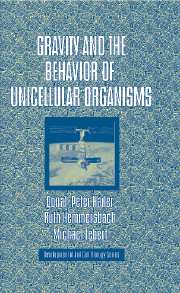Book contents
- Frontmatter
- Contents
- List of Abbreviations
- Preface
- 1 Introduction
- 2 Methods in Gravitational Biology
- 3 Image Analysis
- 4 Ciliates
- 5 Flagellates
- 6 Other Organisms
- 7 Responses to Other Stimuli
- 8 Energetics
- 9 Models for Graviperception
- 10 Evolutionary Aspects of Gravisensing: From Bacteria to Men
- 11 Perspectives
- References
- Index
9 - Models for Graviperception
Published online by Cambridge University Press: 18 August 2009
- Frontmatter
- Contents
- List of Abbreviations
- Preface
- 1 Introduction
- 2 Methods in Gravitational Biology
- 3 Image Analysis
- 4 Ciliates
- 5 Flagellates
- 6 Other Organisms
- 7 Responses to Other Stimuli
- 8 Energetics
- 9 Models for Graviperception
- 10 Evolutionary Aspects of Gravisensing: From Bacteria to Men
- 11 Perspectives
- References
- Index
Summary
Whether a pure physical mechanism is sufficient to describe gravi-related motility phenomena is a question discussed for more than 100 years. The scope of this chapter is not the energetic considerations (cf. Chapter 8 for an in-depth discussion of energetics), but the description of historical and recent models explaining gravitaxis and gravikinesis in ciliates and flagellates. In general, it can be stated that, in most systems, where enough information for a detailed model is available, most likely gravi-related behavior is a combination of both: a physical component and a physiological component.
Since the first discovery of gravitational effects on motile, free-swimming, unicellular organisms, scientists discussed the underlying mechanisms and principles (Schwarz, 1884; Verworn, 1889b; Jennings, 1906; cf. Section 1.1). In general, since the early days, two schools claimed to understand gravity-related phenomena. The “physics” group tried to explain gravitaxis — to the best of our knowledge no physical model for gravikinesis exists — first detected by Dembowski (1929b) as a pure physical phenomenon. The “physiology” group thought of gravitaxis as a typical signal transduction-based cellular response. As usual, the truth will be somewhere in the middle, as we will see later.
Schwarz (1884) was the first who expressed these as a first-glance contra-dictory hypotheses based on his results with Euglena viridis (a close relative of Euglena gracilis).
- Type
- Chapter
- Information
- Gravity and the Behavior of Unicellular Organisms , pp. 165 - 183Publisher: Cambridge University PressPrint publication year: 2005

